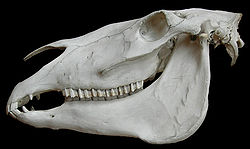Diastema
| Diastema | |
|---|---|

Large diastemata between incisors, canines and molars of a normal horse
|
|
| Details | |
| Identifiers | |
| Latin | diastema |
| TA | A05.1.03.078 |
| FMA | 77271 |
|
Anatomical terminology
[]
|
|
A diastema (plural diastemata) is a space or gap between two teeth. Many species of mammals have diastemata as a normal feature, most commonly between the incisors and molars. Diastemata are common for children and can exist in adult teeth as well. Diastemata are primarily caused by imbalance in the relationship between the jaw and the size of teeth. If the labial frenulum (lip tissue) pulls, it can also push the teeth apart and cause a diastema between the center of the two front teeth.
In humans, the term is most commonly applied to an open space between the upper incisors (front teeth). It happens when there is an unequal relationship between the size of the teeth and the jaw.
Diastema is sometimes caused or exacerbated by the action of a labial frenulum (the tissue connecting the lip to the gum) causing high mucosal attachment and less attached keratinized tissue which is more prone to recession or by tongue thrusting, which can push the teeth apart.
In the Canterbury Tales, Geoffrey Chaucer wrote of the "gap-toothed wife of Bath". As early as this time period, the gap between the front teeth, especially in women, was associated with lustful characteristics. Thus, the implication in describing "the gap-toothed wife of Bath" is that she is a middle-aged woman with insatiable lust. This has no scientific basis, but it has been a common premise in folklore since the Middle Ages.
In Ghana, Namibia and Nigeria, diastemata are regarded as being attractive and a sign of fertility, and some people have even had them created through cosmetic dentistry. In France, they are called "dents du bonheur" ("lucky teeth"). This expression originated in Napoleon's time: when the Napoleonic army recruited, it was imperative that soldiers had incisors in perfect condition because they had to open their powder magazine with the teeth in order to recharge their rifles that they had to hold with their two hands. All those who had teeth apart were then classified as unfit to fight. Some men broke their own teeth to avoid going to war.Les Blank's Gap-Toothed Women is a documentary film about diastematic women.
...
Wikipedia
